From the Archives ...
Sea run trout tactics – Craig Vertigan
Sea run trout tactics – Craig Vertigan
During the trout off-season I tend to spend a bit of time chasing bream, to continue getting a fishing fix, and spend time tying flies and dreaming about the trout season to come. It’s a time to spend doing tackle maintenance, stocking up on lures and dreaming up new challenges and goals for the trout season ahead. When the new season comes around I usually spend the first few months targeting sea runners. Sea run trout are simply brown trout that spend much of there lives out to sea and come in to the estuaries for spawning and to feed on whitebait and the other small endemic fishes that spawn in late winter through spring. Mixed in with the silvery sea runners you can also expect to catch resident fish that have the typical dark colours of a normal brown trout as well as atlantic salmon in some of our estuaries that are located near salmon farm pens. Living in Hobart it is quick and easy to do a trip on the Huon or Derwent and is a more comfortable proposition compared to a trip up to the highlands with snow and freezing winds to contend with.
Read more ...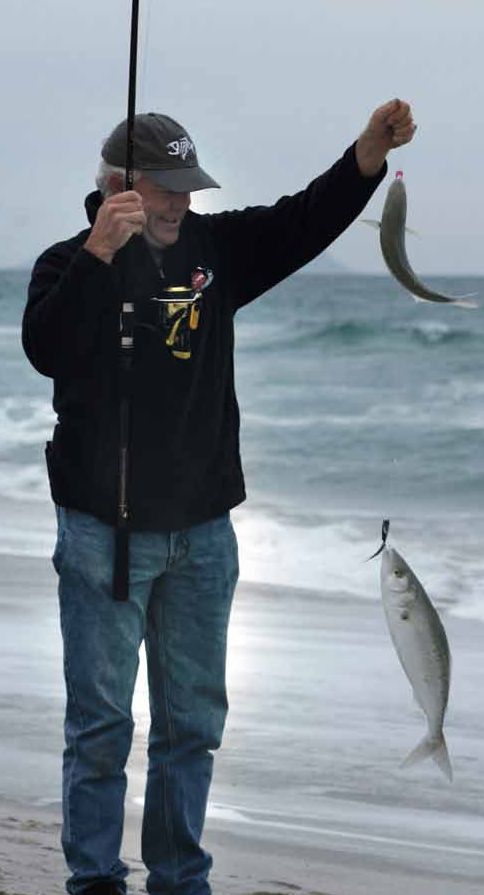 Presented from Issue 101
Presented from Issue 101
For as long as people have been coming to the East Coast of Tasmania, surf fishing its beaches has been one of the most popular pastimes. Whilst not always the most productive form of fishing it certainly is one of the most relaxing. Its something that the whole family can be involved in and I have to say its quite something to see a group of families on the beach, dads with a couple of surf rods out, wives sunbaking on the white sand in the sun and the kids either playing happily, building sandcastles or trying their hand at a bit of light surf fishing.
The chance to have a holiday on the beach, put a smile on the children’s face and wet a line at the same just can’t be overrated. Add to that the chance of putting a fresh feed of fish on the dinner table and you have wonder whether heaven could be better than this
All that is need is a basic range of gear, some comfy camp chairs , an esky full of ice, drinks and food — and of course a separate esky for the bait, sunscreen, hat and sunnies and plenty of time to relax and enjoy the atmosphere. Many of the East Coasts beaches offer very easy access and often some great free camping facilities right on the beach as well as some light rock fishing in some areas.
- Written by Stephen Smith - Rubicon Web and Technology Training
- Category: Saltwater and Estuary Fishing
- Hits: 5594
Read more: Surf’s Up - Fun in the sun - and a few fish too - Jamie Henderson
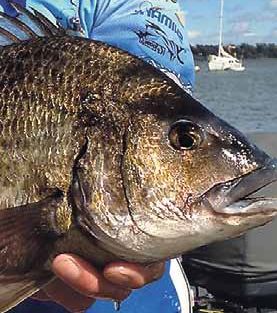 Presented from Issue 101
Presented from Issue 101
What is it about Bream?
While growing up I had the fortune of spending summer holidays at arguably one of the best bream fishing waters in Australia in Ansons Bay. Being young and eager just to feel the weight of a fish on the rod, catching bream was often derailed by chasing the abundant cocky salmon and silver trevally. While these species were on the chew, getting the buzz out of hooking and landing a fish was too much of a temptation. Often schools of bait fish would be busted up in the bay given away by the tell tail signs of seagulls and terns diving in to pick up the scraps left by the salmon as they slammed the abundant anchovies, or what the locals called “sardines”.
- Written by Stephen Smith - Rubicon Web and Technology Training
- Category: Bream
- Hits: 7802
Read more: Bream Lessons and memories from Ansons Bay - Grant Stingel
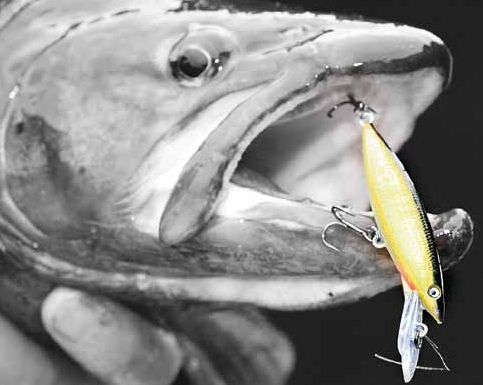
Presented from Issue 100
Considering the world class quality of our sea trout fishery, these fish are not sought after by enough anglers. Sea runners live in the salt water and run up our estuaries and rivers from the start of August to the middle of November. At this time of the year, they are here to eat the many species of fish that are either running up the rivers to spawn or are living in and around the estuary systems. Trout, both sea run and resident (Slob Trout) feed heavily on these small fish which darken in colouration as they move further into fresh water reaches.
The majority of these predatory fish are brown trout with rainbows making up a very small percentage of the catch. They can be found all around the state but it would be fair to say that the east coast is the least prolific of all the areas. They still run up such rivers as the Georges (and many others) but their numbers along with the quality of the fishing elsewhere make it difficult to recommend the area above the larger northern, southern and western rivers.
- Written by Stephen Smith - Rubicon Web and Technology Training
- Category: Saltwater and Estuary Fishing
- Hits: 13579
Read more: Sea runners - Early Season Excitement - Christopher Bassano
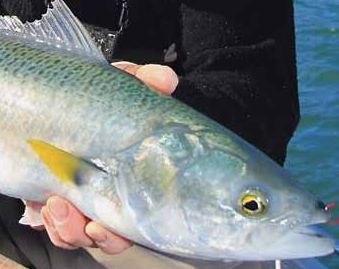 Presented from Issue 100
Presented from Issue 100
In Tasmania, larger Australian Salmon over two pounds are often called Black Back Salmon while the smaller models are known as Cocky Salmon. These fish are a valuable and much loved light tackle sports fish that are enjoyed by both land based and boating anglers all around Tasmania. They are a common catch in our estuaries, along our beaches and rocky headlands, and around the many small islands. They are a schooling fish that are constantly on the move along our coastlines, feeding predominantly on krill and small baitfish. They can be found in an estuary or along a particular part of the coast one week and then gone the next, as they move with the changing tides that influence the food they eat. Their presence rarely goes unnoticed when they turn up, as reports of anglers success quickly filters through the local angling community who gather in large numbers to make the most of these fantastic fish.
- Written by Stephen Smith - Rubicon Web and Technology Training
- Category: Australian Salmon
- Hits: 9900
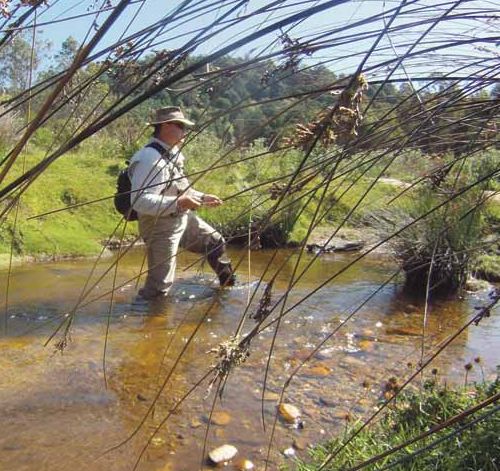 Presented from Issue 99
Presented from Issue 99
For most East Coast anglers the thought of chasing a few trout usually conjures up images of an extended trip to the central highlands, hours of driving, cool temperatures and long hours on the water to make the most of the trip.
However there is some great trout fishing options a lot closer to home than many would think with more than enough variety to satisfy even the most discerning of trout anglers.
With a good mix of river, lake and dam fishing there is something for everyone.
If heading to the rivers my early season recommendations would be definitely some upstream worm fishing in the faster water and small Wattyl Grubs and worms in the slower pools for those wishing to bait fish. A big bunch of scrub worms thread onto a #6 bronze bait holder hook and lobbed unweighted upstream into the tail of runs and eddies is a dynamite technique. If there has been some seasonal rain and the river has broken its banks then its prime time for the worm fisherman, take advantage of the water rising into normally dry drains and into paddocks as the Trout follow and gorge themselves on drowned insects and worms.
- Written by Stephen Smith - Rubicon Web and Technology Training
- Category: East Coast
- Hits: 16242
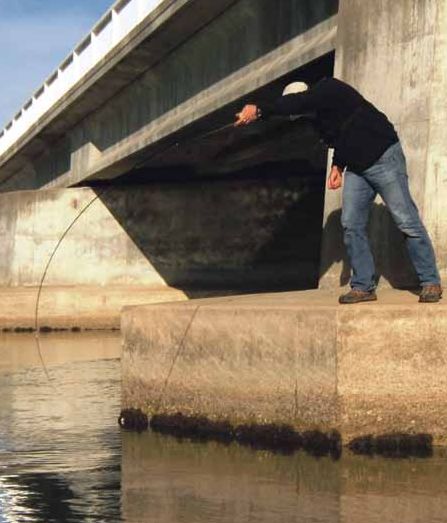 Presented from Issue 99
Presented from Issue 99
The annual spawning run or should I say flood of bream to the Scamander River is well underway. Earlier in autumn small schools of adult fish accumulated around the snags in the lower channel of Georges Bay ready for the long run south. When their numbers built up they made the mad dash down the coast and at times could be seen skirting the rocks of St Helens Point as they went.
Along the way they were joined by fish from Dianas Basin and Wrinklers Lagoon when these lagoons were open to the sea. At the same time fish travelled north from Four Mile Creek and Henderson’s Lagoon massing in the surf at the mouth of the river. At the top of the incoming tide fish moved in through the mouth of the river and gathered around the best two snags the Scamander River has to offer- the bridges. Now in late winter, their destinations are the long stretches of brackish water that will provide the right environment for the food their progeny will need after they hatch.
- Written by Stephen Smith - Rubicon Web and Technology Training
- Category: Bream
- Hits: 10821
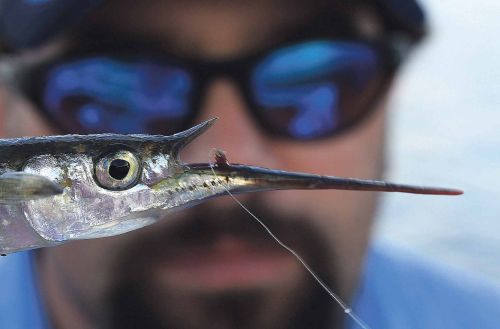 Presented from Issue 98
Presented from Issue 98
Wish list, bucket list, call it what you will, I think most of us have one. They seem to come about from conversations with other anglers about different places they have fished, things we have seen on TV or articles we have read in publications such as this one. Some of far-flung places and exotic species but others a little less expensive. This is certainly the case with me; some things just stick in my mind. An article I read many years ago by a well-known fishing journalist whose face adorns many soft plastic packets was fishing for garfish on fly. This undertaking was purely about familiarisation with his fly rod, before he went on a trip to New Zealand. It started out with some burley on the water to attract garfish in an estuary close his home and culminated in him standing up to his crown jewels, in his underwear, with two garfish stuffed down the back of his jocks and a fly hook firmly stuck in his finger. It was more than just the humour of the article that stuck with me and with my interest piqued, I told myself I’d have a crack at garfish on fly one day but I’d give the fish down the back of the jocks a miss! Fifteen years later Jamie Henderson asked me if I would like to spend the afternoon on George’s Bay chasing garfish. “Here is a chance to tick one off the bucket list” I thought and eagerly accepted.
- Written by Stephen Smith - Rubicon Web and Technology Training
- Category: Saltwater and Estuary Fishing
- Hits: 6847
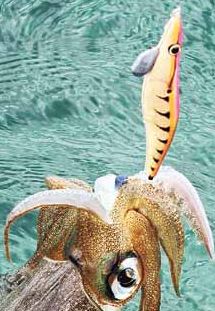 Presented from Issue 98
Presented from Issue 98
What is egi?
About 400 years ago a bloke in Japan was looking at squid in the harbour, while fishing, and thought there has to be a better way to catch these things. Until then the techniques were a dip net and teaser bait, cast or drag net. He studied the squid for some time and observed that the squid would prey on fish and shrimp as they slowed or stopped. After much trial and error he created an artificial bait that would suspend or sink very slowly in the water, and hopefully attract the squid to the artificial bait.
He called this artificial bait egi.
At that stage it did not have barbs on the lower part of the egi and was used to excite the squid to attack and come close enough to pick up with a dip net. After much success attracting squid to the egi, but still having difficulty netting squid more thought came into the design.
- Written by Stephen Smith - Rubicon Web and Technology Training
- Category: Saltwater and Estuary Fishing
- Hits: 12615
Read more: Egi and the squid - An unexplored Tasmanian sport fishery
Presented from Issue 97
Rebounding stocks of Eastern Australian Salmon along the eastern coast and a revealing study into the salmon’s life history have prompted Fisheries NSW to refine the balance between conservation, sport and industry.
Research findings from an FRDC-funded project have resulted in Fisheries NSW relaxing a 10- year restriction on the commercial take of Eastern Australian Salmon along the NSW coast, north of Barrenjoey Head.
The revised management code for northern NSW replaced a daily bycatch limit of 100 kilograms and permits allowing fishers to retain Eastern Australian Salmon as bait, with a 224-tonne-a-year commercial fishery as of 1 December 2011.
- Written by Stephen Smith - Rubicon Web and Technology Training
- Category: Australian Salmon
- Hits: 7289
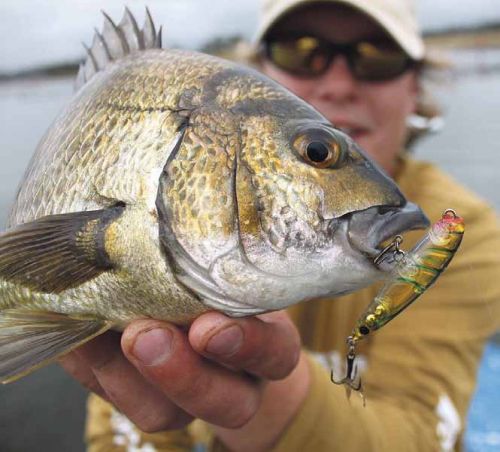 Presented from Issue 96
Presented from Issue 96
I don’t think fishing gets any better than watching something come up to the surface and eat a lure off the top. If you’re like me and you love chasing those big Tasmanian bream on lures, then you might have considered casting a surface lure at one time or another. Plenty of people might tell you that “it’s a waste of time”, “black bream don’t like surface lures” or “the water is too cold down here”. Any other number of reasons not to do it might come up. I’m writing this article in the hope that I can disperse that myth and instil confidence in anyone who remains a sceptic. For last three years I have sought out bream on topwater lures in almost every recognised bream estuary, through every month of the year and in every weather condition. You might be surprised to learn that throughout this time I have had very, very few days where I didn’t get at least one fish.
Some days are definitely harder than others but in the end, good things come to those who wait. Hopefully I can pass on some information through this article that will help you in your search for that big topwater bream.
- Written by Stephen Smith - Rubicon Web and Technology Training
- Category: Bream
- Hits: 9662
Subcategories
Current TFBN
Click above for current issue content. The current issue of TFBN is extensive and topical. In Tackle Stores, Newsagents and by subscription.
Delivered to your door for $48 for 2 years (8 issues). To subscribe, send Mike $48 via www.paypal.com.au . (Basic instructions are here) The email is at Contact Us. Your address will be included from PayPal.
Or phone Mike with your c/c handy on 0418129949
Please ensure your details are correct, for Mike to organise delivery.
TFBN Newsletter Sign up Form
Why not submit an article ?
When you have finished for the day, why not have a brag about the ones that didn't get away! Send Mike an article on your fishing (Click here for contact details), and we'll get it published here. Have fun fishing - tasfish.com
Category Descriptions
Here is a list of all of the Article Categories. The number in Brackets, eg (13) is the number of articles. Click on Derwent River and all articles relating to the Derwent will be displayed in the central area.
Articles by Category
-
Rivers (3)
-
Saltwater and Estuary Fishing (149)
-
Kayak Fishing (34)
-
Lakes (1)
-
Great Lake (62)
-
Lake Leake (52)
-
Woods Lake (16)
-
Lake Augusta (11)
-
Huntsman Lake (13)
-
Lake Pedder and Gordon (10)
-
Lake Dulverton (5)
-
Lake Crescent (6)
-
Tooms Lake (10)
-
Lake Mackintosh (2)
-
Lake Barrington (5)
-
Little Lake (8)
-
Meadowbank Lake (5)
-
Lake King William (7)
-
Lake St Clair (2)
-
Western Lakes (12)
-
Arthurs Lake (35)
-
Lake Echo (7)
-
Four Springs (54)
-
Lake Sorell (7)
-
Lake Burbury (6)
-
Other Lakes (57)
-
Brushy Lagoon (18)
-
Little Pine Lagoon (5)
-
Penstock Lagoon (16)
-
Brumbys Creek (7)
-
-
Events (48)
-
Estuary Fishing (0)
-
Coastal Catches (46)
-
Super Trawler (46)
-
IFS, DPIPWE, MAST and Peak Bodies (435)
-
Commercial Interests (98)
-
Other (24)
-
TFBN Back Issues (8)
-
Fly Fishing (67)
-
Trout Fishing (250)
-
Meteorology and Weather (8)
-
Jan’s Flies (50)
-
Tuna Fishing and other Game Fishing (86)
-
Cooking Fish (19)
-
Fishing Information (1)
-
Fishing Books (8)
-
Videos (5)
-
Tackle, Boats and other Equipment (146)
-
World Fly Fishing Championship 2019 (2)
Popular Tags
windyty.com
Visit https://www.windyty.com/
Rubicon Web and Technology Training
Hello everyone, I thought it would be a good time to introduce myself.
My name is Stephen Smith and I have been managing the website tasfish.com since May 2009.
It has been an epic journey of learning and discovery and I am indebted to Mike Stevens for his help, support and patience.
I am developing a new venture Rubicon Web and Technology Training ( www.rwtt.com.au ). The focus is two part, to develop websites for individuals and small business and to train people to effectively use technology in their everyday lives.
Please contact me via www.rwtt.com.au/contact-me/ for further information - Stephen Smith.
From the Archives ... (last chance)
Sea Run Trout
Mid Sea-Run Season Report
Sea-run trout fishing this year got off to a cracking start in most areas, with the majority of anglers employing nearly every trout fishing technique to secure fish in local estuaries statewide.
Even those anglers fishing the "off-season" lower down in our estuaries for sea-trout commented on the number of fish moving in early August.



